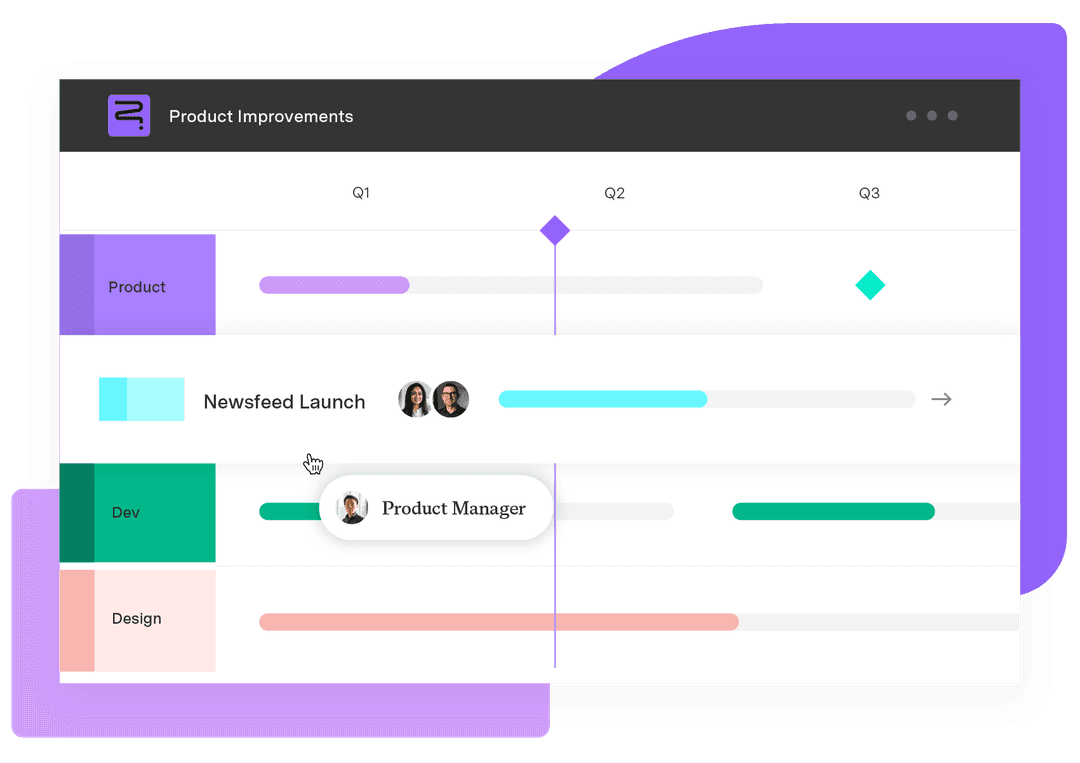Why product sense is crucial for product managers
Tempo Team
The electric kettle, Polaroid cameras, and the Palm Pilot—these popular products had a profound, lasting effect on consumers and the marketplace from the moment they launched. But these items didn’t simply appear. They sprung from hard work by product managers (PMs) and their teams, who leveraged their understanding of the technology’s potential, their audience’s wants, and, most importantly, customers’ needs.
When combined, these insights are labeled product sense. To the uninitiated, product sense looks like intuition; to a certain degree, it is. However, it’s also a skill that develops with time and practice. Visionaries like Steve Jobs aren’t born. They’re made.
If you want to hone your product management skills, begin by developing your product sense.
What is product sense?
When evaluating a product idea, instinct only gets you so far. To grow market share beyond initial product discovery, you must understand what drives consumers to purchase and how the product’s evolution will continue to solve problems or fulfill audiences’ needs. That’s where product sense comes in.
Product sense is a skill set that helps product managers conceptualize a new item, establish the product roadmap, prioritize feature development, and ultimately build a creative solution to meet consumers’ needs.
A senior product manager’s product sense toolbox includes skills like:
Market research
User experience (UX) design
Business strategy
Project management
Domain knowledge
According to Shreyas Doshi, former Stripe product manager and well-known product sense coach, domain knowledge is the most vital asset. Product managers must also employ cognitive empathy and creativity.
By combining these competencies, you’ll build products that stand out in the marketplace. Consider these examples:
iPhone
Few companies share Apple’s track record for developing the types of products its market craves. The iPhone initiative identified a market gap and created a product based on a fresh perspective of the cellular phone’s potential and its audience’s desires.
Apple noted Blackberry’s success and began searching for the next evolutionary phase. After extensive user research, Apple determined that a large touchscreen and intuitive interface would resolve pain points left unaddressed by competitors. Thus, the modern smartphone was born.
Airbnb
Airbnb shows what happens when an organization prioritizes understanding users’ needs. Developers recognized that vacationers want an authentic travel experience. In response, they created the Airbnb platform to allow property owners to rent their homes to vacationers. Homeowners generate additional income while vacationers enjoy a unique and lasting cultural experience unavailable at hotels or resorts. It’s a win-win.
5 tips for developing product sense
If you want to develop products that have a lasting impact on consumers and industry, focus on the following advice:
1. Study your audience
Conduct market research and user testing to learn about your target audience and their needs. From their feedback, you’ll gain insight into what they want from your product and which features to prioritize.
2. Analyze your competitors
You can learn a lot from others within your industry. Review the competitive landscape to identify gaps in the marketplace your product can fill.
3. Establish goals
Align your product strategy with business goals, considering factors like pricing, marketing, and distribution.
4. Test and iterate
Constant improvement is the only way to stay on top of the market. Teams that gather and act upon user data and a product critique pool can continuously develop new features and designs. They’ll maintain a product that adapts to consumers’ evolving needs.
5. Strategize your product approach
Assess customer reviews regularly to identify popular features. Then, establish a product roadmap that prioritizes developing these utilities to meet market demand.
Here’s how product managers at Reddit, Hinge, Webflow, and more see product sense
Product sense is a nebulous mix of intuition and hard and soft skills, making it challenging to master. Here are additional insights into the process from some well-known product development professionals to help you find your way.
Can you lose product-market fit? | With Ramli John, Productled & Appcues
Ramli John lives and breathes product development. When he isn’t fulfilling his role as Content Director at Appcues, he’s a podcaster, author, and startup mentor. For him, product sense weighs empathetic and holistic consumer understanding against hard data.
That balance is imperative. Swaying too far toward an empathetic perspective could blind PMs to the full range of client needs, whereas relying solely on data can alienate customers.
Instead, focus on creating a product customers will proudly share while maintaining an ongoing conversation to keep in touch with their needs. The market moves faster than you can collect data, so real-time insights are crucial.
What does product sense look like at a startup? | With Kristin Chen, Metatheory Inc. & Soundcloud
Now an independent consultant, Kristin Chen has worked for prominent online enterprises, including LinkedIn, Metatheory, and Soundcloud. An expert in scaling, she understands product sense works differently in a startup environment.
In her experience, product sense starts at the top, and its initial incorporation into the corporate culture is imperative. Customer needs will change over time. As soon as possible, engage and mingle with them in various arenas to identify their pain points and ways to evolve your product. These insights allow your product sense to work proactively, giving your team time to develop new features before your clients know they need them.
While feedback is critical to long-term success, beware of the loudest voice in the room. Biased feedback processes alienate segments of your customer base, so be prepared to balance being data-driven and data-informed.
A scientific approach to product sense | With Avrum Laurie, Wealthsimple & Felix
According to Avrum Laurie, formerly of Wealthsimple and now Chief Product Officer at Felix, the best product managers synthesize information from multiple sources, taking a scientific approach to finding solutions. They also educate and coach their team in systemic problem-solving. This strategy helps the product group craft compelling user stories and identify market fit, especially in a startup environment.
Another crucial practice in developing product sense is becoming familiar with users’ needs by using the product. It sounds simple, but confusing your experience with that of the customer can lead to bias.
Are user interviews a waste of time? | With Michelle Parsons, Hinge & Lex
Generating actionable feedback is essential to developing product sense. According to Michelle Parsons, Chief Product Officer at Lex, how you communicate is half the battle.
Customers rarely have the vocabulary necessary to describe the issues they face, so it’s up to the PM to diagnose and prescribe fixes by focusing less on what people say in customer interviews and more on how they engage with the product. This approach helps you ideate and co-create potential solutions with your customers before launching the product or feature.
Also, beware of silos between qualitative and quantitative data. Solely relying on one or the other can lead your team astray. Instead, use your intuition to contextualize both and build an accurate customer journey from the outset.
How Webflow PMs use product sense to drive roadmaps | With Frank Ramirez, Webflow & Nimble
Nimble’s VP of Product, Frank Ramirez, believes honing one’s product sense is vital to successful long-term decision-making. Product sense often starts as an educated guess, but unchecked assumptions can become damaging if they don’t develop beyond intuition.
Incorrect assumptions produce adverse, compounding effects that can be expensive to correct. Avoid them by building organization-wide best practices to help PM teams speak the same language. Apply processes to build customer empathy and market understanding while reducing risks. Design and QA teams can then roadmap product release and iteration cycles to prioritize impactful feature development.
Your product, your community, your emotional wheels | With Peter Yang, Reddit & Roblox
For Peter Yang, Principal Product Manager at Roblox, product sense requires tuning into customers’ emotions when they use your products.
Think about what the press release will read when you launch a new product. Ask yourself:
Who did you build this product for?
What are the outcomes?
What will it help users achieve?
Then, determine which feelings you hope your customers will experience when using your product and optimize for them. Otherwise, you could attempt to solve too many problems, diluting the effectiveness of your product and creating a mediocre solution.
Also, many PMs focus too heavily on data and lose sight of the client, so balance being metric- and customer-obsessed. Encourage team discussions using the same language as customers. Using the same terminology will build alignment between internal stakeholders and clients.
Conclusion
Product sense is an invaluable tool for developing innovative products that users will love. But knowing what customers want isn’t enough. You must create a plan to help management and leadership visualize the product journey.
Tempo’s Strategic Roadmaps application helps you capture customer feedback, prioritize next steps, and communicate your product strategy to the C-suite. The solution is quick and easy to use, letting you create boardroom-ready roadmaps and build organizational alignment in minutes.














































